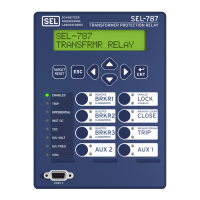
Do you have a question about the Schweitzer Engineering Laboratories SEL-787-3 and is the answer not in the manual?
| Device Name | SEL-787-3 |
|---|---|
| Category | Relays |
| Frequency Rating | 50/60 Hz |
| Voltage Inputs | 3 |
| Current Inputs | 6 |
| Communication Ports | Ethernet, Serial |
| Current Rating | Up to 5 A |
| Protocols Supported | IEC 61850, DNP3, Modbus |
| Protection Functions | Overcurrent |
| Operating Temperature | -40°C to +70°C |
| Operating Temperature Range | -40 to +85 °C |
| Mounting | Panel |
| Enclosure | Metal |
| Input/Output | Configurable |
Describes core protective functions like differential, overcurrent, and breaker failure.
Covers volts/hertz, over/underfrequency, and over/undervoltage functions.
Details synchronism check and DC battery monitoring capabilities.
Covers through-fault and temperature monitoring using RTDs.
Explains front-panel pushbuttons and LEDs for control.
Discusses ACSELERATOR QuickSet for settings and logic programming.
Highlights built-in metering and event reporting capabilities.
Details dual-slope differential protection with harmonic blocking/restraint.
Describes sensitive ground-fault detection for wye transformers.
Covers instantaneous and time-overcurrent elements with SELOGIC control.
Explains IEC and IEEE time-overcurrent characteristics and elements.
Details elements for ring-bus or breaker-and-one-half systems.
Describes protection logic for breaker failure scenarios.
Covers overexcitation detection using voltage and frequency.
Details phase, phase-to-phase, and sequence over/undervoltage elements.
Explains logic to detect loss of voltage transformer input.
Describes synchronism check and DC battery monitoring capabilities.
Covers frequency elements for over/underfrequency conditions.
Details operator controls, pushbuttons, and LEDs on the front panel.
Explains functions like LOCK, BRKRn, CLOSE, TRIP, and AUXn.
Shows application for a 3-winding transformer with specific protections.
Illustrates autotransformer protection with voltage-based functions.
Discusses tracking accumulated through-fault I²t values for maintenance.
Lists capabilities for settings, monitoring, and testing.
Details quantities measured by the SEL-787, including currents and voltages.
Explains using SEL software for viewing system angles.
Describes monitoring breaker wear for maintenance scheduling.
Discusses gathering current level, duration, and date/time for through faults.
Covers post-fault analysis using event reports and SER data.
Lists various communication protocols supported by the relay.
Details available serial ports (EIA-232, EIA-485, Fiber-Optic) for communication.
Eliminates traditional switches with 32 local bits and SELOGIC control.
Removes RTU wiring using 32 remote bits and SELOGIC equations.
Replaces latching relays with latch bits and SELOGIC for custom functions.
Replaces panel lights with 32 programmable displays for custom messages.
Eliminates external timers with 32 general purpose SELOGIC timers.
Supports selectable setting groups for frequent changes and system adaptation.
Provides SER events to automated systems via unsolicited binary messages.
Illustrates basic Ethernet network setups with switches.
Shows dual redundant and ring structure network configurations.
Details bidirectional relay communication for coordination.
Lists optional hardware and software features available for order.
Describes the 24 tricolor LEDs for status and trip indication.
Explains voice message alerts for relay events via SEL-3010.
Covers custom labeling for operator controls and LEDs.
Shows the front panel layout with default configurable labels.
Details the rear and side panel connections for the 787-4X.
Shows the front panel layout for 787-3E/S with configurable labels.
Details rear and side panel connections for the 787-3E.
Details rear and side panel connections for the 787-3S.
Provides physical dimensions for rack and panel mounting.
Covers compliance, general AC/DC inputs, and power supply specs.
Details fuse specifications and output contact capabilities.
Lists standard contact ratings and DC output specifications.
Covers AC output ratings, control signals, and analog outputs.
Details specifications for frequency tracking and phase rotation.
Lists communication ports and environmental test standards.
Specifies operating temperature range and humidity requirements.
Covers dielectric, impulse, RFI, and EMC immunity tests.
Details processing intervals and oscillography settings.
Provides accuracy details for metering quantities like currents and voltages.
Details accuracy for synchrophasor measurements and voltages.
